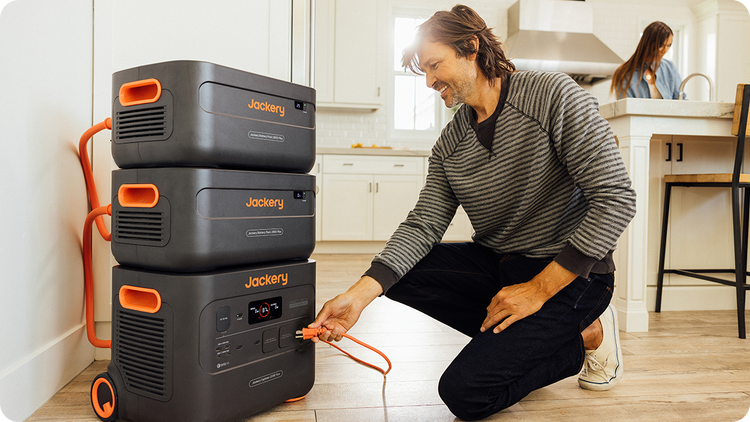Understanding Traditional Power Backup Options
Uninterruptible Power Supplies (UPS)
A UPS is between loads and the primary power source. It uses an inverter, rectifier, and an internal energy storage component (VRLA, AGM, or Li-ion batteries) to smooth out voltage fluctuations, filter noise, and an immediate bridge during an outage. Standby models are the simplest and switch to battery power only when voltage drops, which can cause a brief but negligible transfer time. Line-interactive designs add a buck-boost transformer that adjusts for overvoltage and undervoltage conditions for lower battery wear and more stable output. Online double-conversion units run the load continuously on the inverter for an isolated and clean waveform. It is key to environments with frequent brownouts or harmonics-sensitive equipment.
Such devices include diagnostic firmware that tracks temperature, battery charge cycles, and efficiency percentages for predictive upkeep. In large-scale setups, redundant UPS modules with hot-swappable battery banks minimize single points of failure. Meanwhile, smaller sites benefit from rack-mounted forms with integrated ATS controls. Such UPS units can also interface with generator start signals for continuity until a long-term power backup option takes over. Synergy with BMS guarantees exact load-shedding procedures and battery health for European data centres, which renders this short-term power backup solution key to infrastructure design.
Portable Generator
A power station portable outspreads coverage when primary grid stoppage persists beyond the short window that a UPS can handle. The generators have built-in AVR for stable electronics and industrial equipment output in European power contexts. Gasoline models are easier to procure and start. Yet, they have higher running costs and need more maintenance due to combustion byproducts. Diesel generators offer lower fuel consumption under heavier loads and tackle continuous operation more reliably, but they can be more sensitive to cold starts and demand winter-grade diesel in colder regions. Propane-fueled systems burn cleaners and moderate issues with fuel storage degradation, but they need reliable gas cylinder supply and carburation setups. Units integrate low-total-harmonic-distortion inverters for computers, lab instruments, or manufacturing controls. Sizing matters. Oversizing can waste fuel and cut working efficiency. Undersizing can cause damaging voltage drops and mechanical stress. European noise regulations can demand acoustic enclosures or stealth generator cabinets with spark arrestors and high-tier mufflers. Many home or business owners incorporate ATS panels to automate power backup transitions whenever the mains voltage dips. It depends on microprocessor-based controllers that monitor line frequency and system load. Such generators are a critical power backup resource for lengthy outages. However, all of them can emit harmful gases that damage the environment, undermining the EU’s goal of achieving climate neutrality by 2050.
The Rise of Solar Power Backup Solutions
Market Trends in Europe
European grids become more dynamic as decentralized solar systems feed power into local distribution networks. Germany and Spain have updated grid codes to cope with rapid fluctuations in solar output, which can stress infrastructure if not managed. Utilities are implementing virtual power plants to aggregate solar arrays under unified control and offset demand spikes. Lithium-ion battery capacity for home and commercial installations has surged for sites for reliable power backup during unpredictable outages. Many projects are experimenting with hybrid inverters that integrate solar generation and energy storage into a single interface. It can simplify compliance with VDE-AR-N 4105. The standard mandates efficient voltage and frequency regulation at the point of common coupling.
Large corporations are piloting microgrid setups that use solar arrays, battery banks, and fuel cells for power backup in remote or industrial sites. Utility-scale solar power storage batteries in Italy and the Netherlands use BMS to coordinate state-of-charge across racks for better life and lower degradation. Solar-plus-storage providers in France have also shifted from feed-in tariffs to self-consumption frameworks. It pushes designs that match inverter output to load profiles. Improvements in silicon wafer manufacturing with perovskite research in the UK promise higher module efficiencies and a lower levelized cost of electricity. Many regions now encourage time-of-use tariff structures to incentivize discharging energy into the grid during peak demand. It can strengthen a facility’s financial returns and decrease stress on conventional generation assets.
Advantages of Solar Generators
Solar generators offer well-regulated DC outputs, which cut conversion losses when powering equipment. Designs may feature modular MPPT channels that can adjust current flow under partial shading. They can also include LiFePO4 packs with intelligent monitoring for protracted life and more accurate state-of-charge estimation. Such architecture gives stable power backup and high round-trip efficiency. Thanks to direct sunlight, a solar generator averts over-reliance on fossil-fueled emergency units and lowers carbon intensity. A well-designed unit can interface with home energy management systems through Modbus or CAN bus. It streamlines power backup management with real-time adjustments per load priority and weather forecasts.
Many models can operate in island mode to keep circuits active during grid disturbances. They meet noise-level requirements that suit residential or hospital settings. Portability has also developed beyond simple handles and compact casings. Some models have swappable battery modules and inverter topologies for quick reconfiguration in field applications. Even in large-scale commercial setups, rack-based lithium modules can be scaled up or down to satisfy specific energy demands. Over time, declining prices for solar-grade silicon and progressive battery chemistries have made such solutions accessible. Consequently, more organizations can adopt solar-based power backup systems without losing reliability or operational agility.

Power Backup Solutions from Jackery
We designed the Jackery Solar Generator 2000 Plus with LiFePO4 battery technology for durability, a rated output of 3000W (6000W surge), and the capacity to expand from 2 kWh to 24 kWh while connecting up to five add-on battery power packs. So, it becomes an ideal power backup for lengthy outages in Europe. Each charge cycle sustains at least 70% of its original capacity after 4000 uses. Also, our ChargeShield variable-speed algorithm boosts the battery life by 50%. We’ve confirmed a fast recharge time. Six Jackery SolarSaga 200W Solar Panels can replenish the system in about two hours. The AC adapter needs 1.7 hours to go from empty to full.
The standard 230V, 50Hz outputs fit Europe’s grid requirements. Moreover, we include 3 AC outlets, 2 USB-A outputs, and 2 USB-C outputs. Our system powers a 2200W weeder for 2.3 hours or a welding machine (5800W peak) for a shorter but critical duration. That proves its worth as a power backup in emergencies. Monocrystalline silicon solar cells on our panels deliver up to 25% efficiency, and the add-on battery packs can also be charged directly by solar panels. Our TÜV SÜD carbon footprint verification shows that we’re committed to manufacturing efficiencies and decreased environmental impact. At the same time, the 10-year lifespan (even under frequent usage) provides extended peace of mind for European households.

Implementing a Comprehensive Power Backup Strategy
Assessing Individual Needs
When designing a power backup plan for your European facility, you must analyse each load in granular detail. Look at every system, including temperature-sensitive lab equipment and large-scale industrial motors. Note the startup surge currents, constant running loads, and harmonic distortions they produce. Conduct load monitoring over a complete operational cycle to capture peak demands and any transient spikes that could overwhelm your power backup during heavy draws. Factor in Europe’s standard grid frequency and local distribution norms (230 V single-phase or 400 V three-phase). That’s because the wrong inverter configuration can create synchronization issues with devices. Gather data on power factors, total harmonic distortion, and non-linear behaviours that could hamper battery-based systems or generator control circuits.
Battery chemistries like lithium iron phosphate for high cycle stability should be considered if energy density is dominant. Nevertheless, confirm compatibility with your site’s environmental regulations and temperature ranges. Calculate autonomy times with real-life scenarios in mind, including multiple outages in a single day or a protracted grid failure. Incorporate enough buffer to tackle successive discharge and recharge cycles. Evaluate your operational priorities, decide which loads get top preference when power backup capacity is limited, and address compliance requirements from local grid authorities. Last but not least, factor in each sub-system’s bandwidth for expansion. The reason is that unanticipated future loads can stress your power backup if you’ve under-dimensioned capacity at the planning stage.
Integrating Multiple Solutions
Once you know the demands, combine different technologies and architectures to build a layered defence against outages and voltage drops in Europe’s different power backdrop. Pair a high-efficiency UPS with a solar generator for long coverage and incorporate battery storage to deal with short-duration interruptions since a generator’s startup delay could be detrimental. Use intelligent transfer switches that monitor frequency stability, voltage sag, and harmonic content in real so they can reconfigure your power backup system if grid conditions go out of tolerance. Look into supercapacitors or flywheel energy storage for scenarios needing rapid discharge to cover spikes. Subsequently, let your battery manage longer durations.
For facilities that want to avoid fossil fuels, plan a hybrid approach that ties solar photovoltaic systems to your power backup via bidirectional inverters. Synchronize them with local grid codes or region-specific standards. Integrate a dynamic load management system that can shed non-critical loads whenever the total draw approaches the maximum threshold and track everything through an industrial-grade SCADA or IoT-based platform for optimization. Implement real-time reactive power control to moderate power factor penalties and decrease stress on the generator or battery inverters. Cross-check voltage phase imbalances if you’re running a combination of single-phase and three-phase loads. That’s because any mismatch in the current draw can degrade power backup performance and reliability.
Regular Maintenance and Testing
After putting multiple layers in place, guarantee inspections to keep your power backup functioning. Even the best-engineered strategy can fail without upkeep. Schedule battery impedance testing at recommended intervals to detect premature ageing in large banks that risk voltage sag under load. Perform generator load bank tests under real operating conditions to confirm adequate fuel flow, cooling efficiency, and alternator performance when delivering power backup for a long. Validate transfer switch operation monthly while simulating partial and full load transfers and rotate between operational modes if you have multiple redundancy setups. Keep an eye on firmware revisions for all intelligent components, including control panels and inverter systems. Minor software bugs can impact synchronization or protective relay functions.
Inspect cooling systems and temperature sensors if your site experiences temperature swings that might tax battery thermal management. Track each part’s service life, and keep logs of operating hours and events so you can replace parts before they fail. Monitor the health of any renewable sources while measuring daily energy yields. It verifies that inverters are fully functional and that backfeed protection meets national grid codes. Finally, conduct black-start drills to mimic total grid loss, running through a worst-case scenario. Hence, your power backup transitions and monitoring systems are active. Every piece of hardware and software responds as engineered.
Conclusion
The power grid of Europe faces increased power interruptions because of storms and shifting solar energy patterns. Short power outages need a UPS system, yet multiple generators with solar arrays are necessary for blackout situations that last longer than a few minutes. The storage function of solar generators leads to lower dependency on fossil fuels. A battery backup for refrigerator use can keep food from spoiling when the power cuts out. When selecting backup systems, choose a capacity matching the total surge loading and appliances’ power requirements. Maintenance exercises should be conducted so all backup systems function correctly. Check the condition of battery systems, generator operations, and hybrid system control parameters. Monthly short tests with periodic complete load tests help establish peace of mind during system operation.









